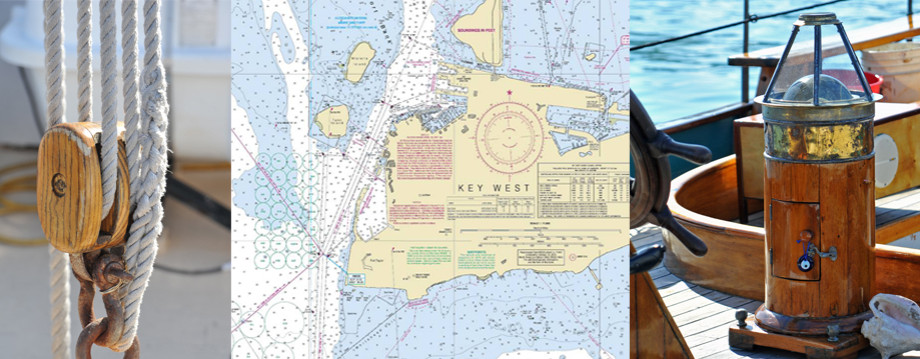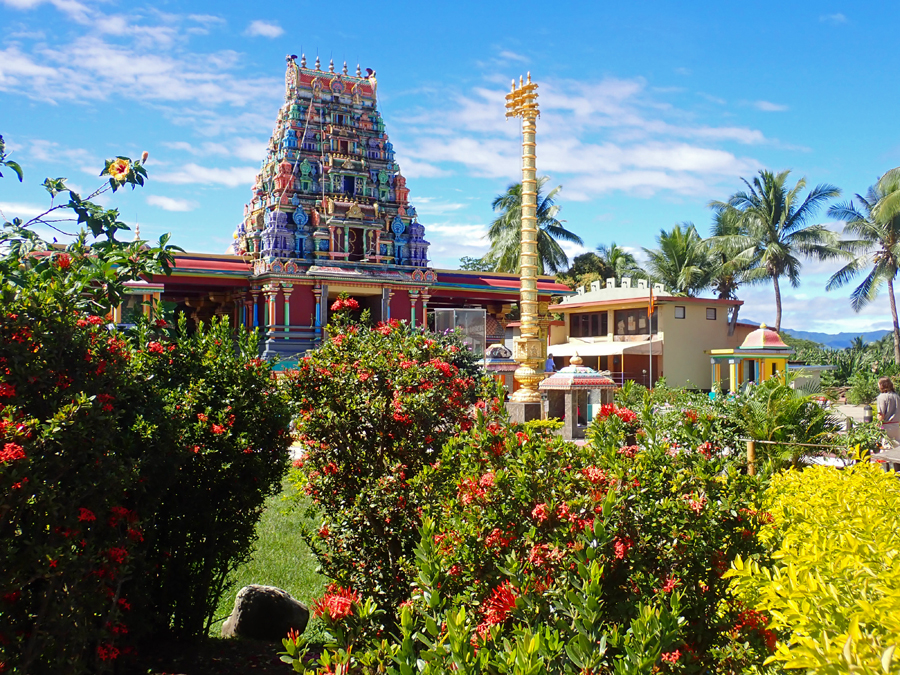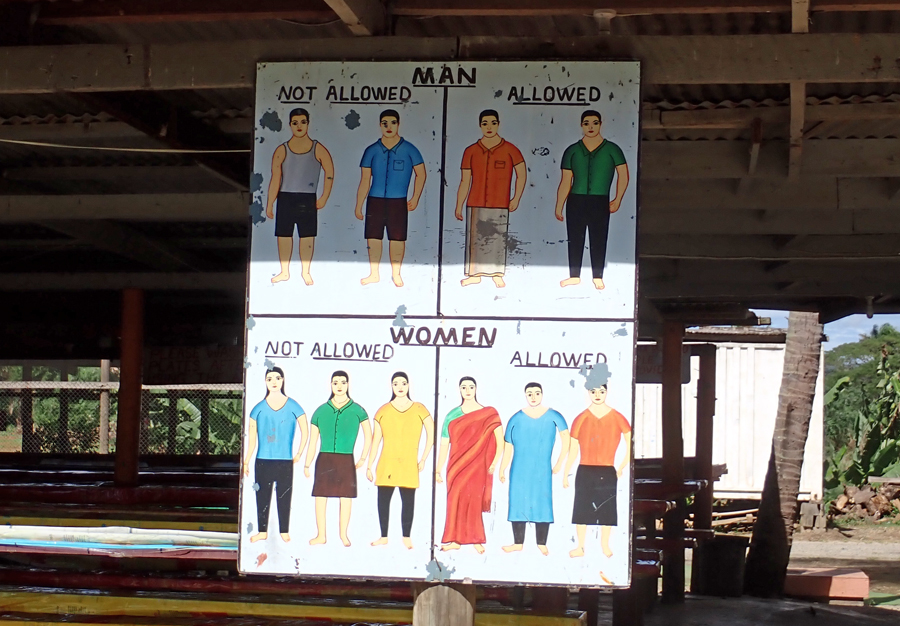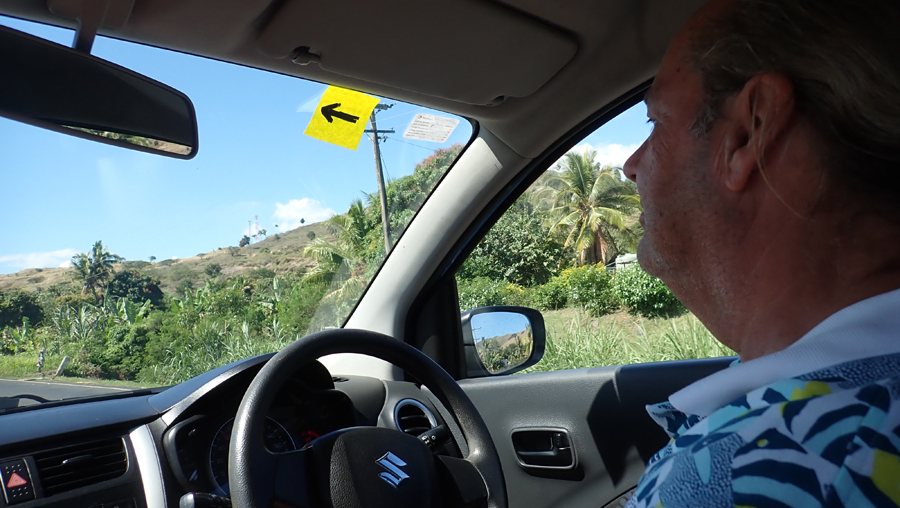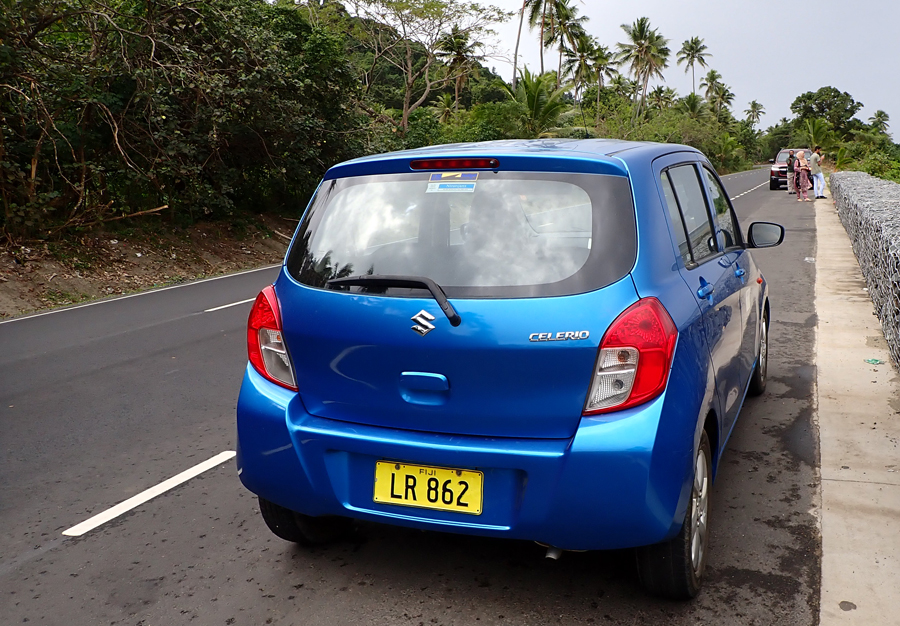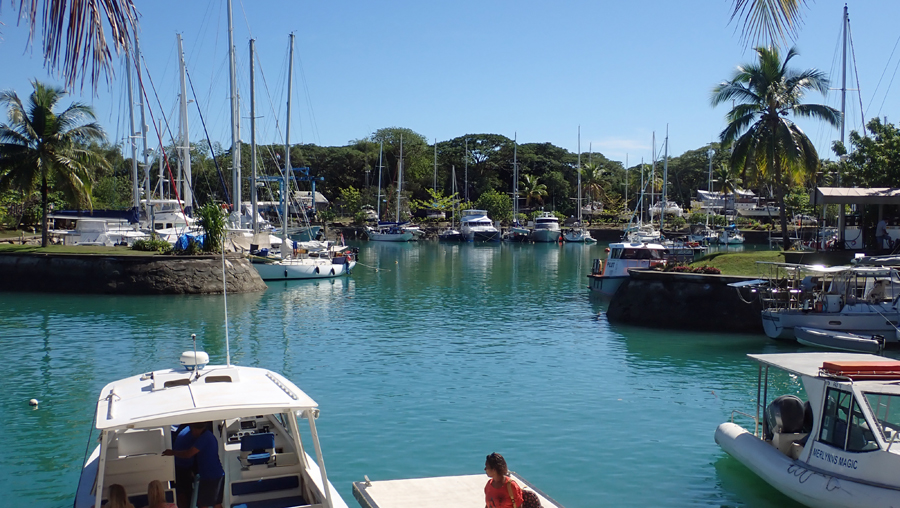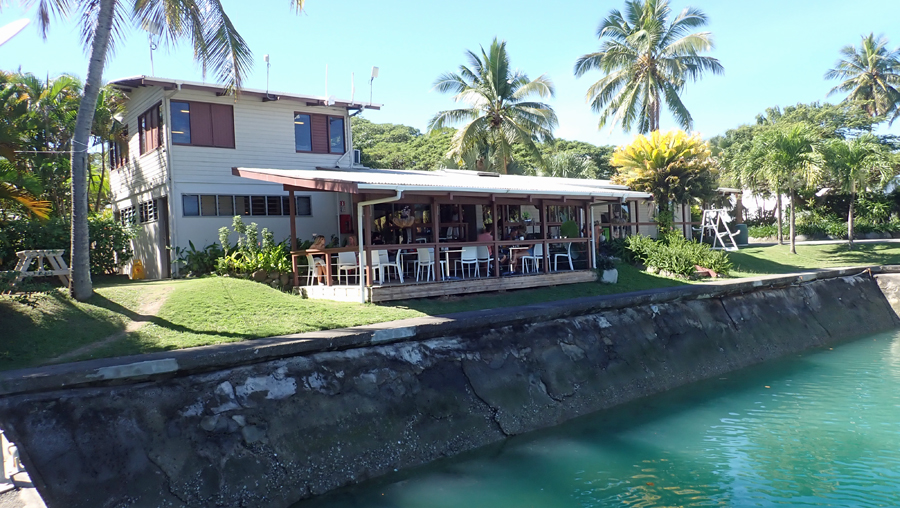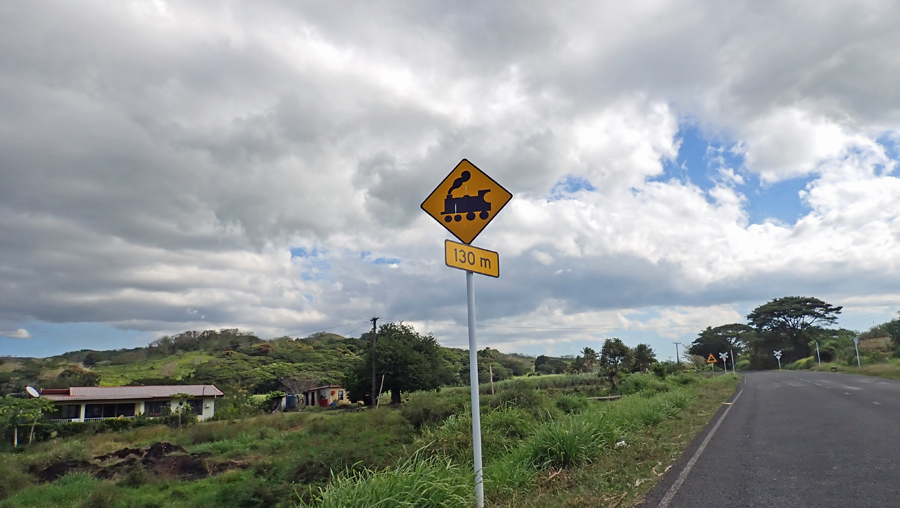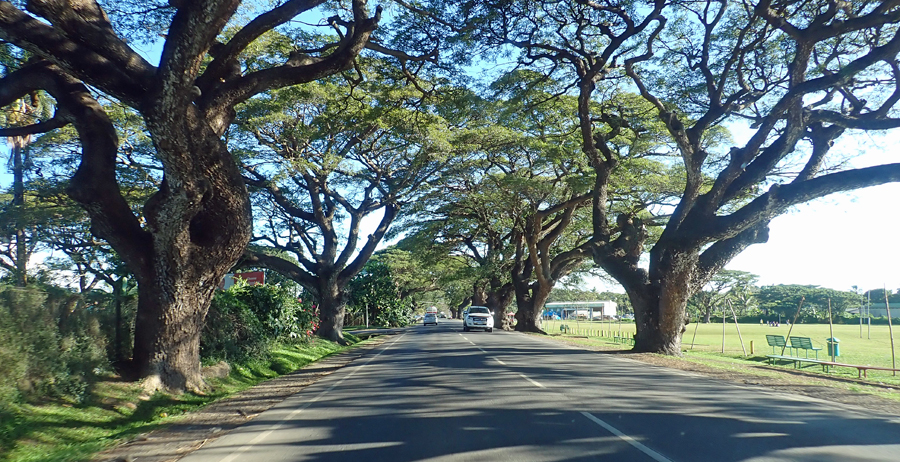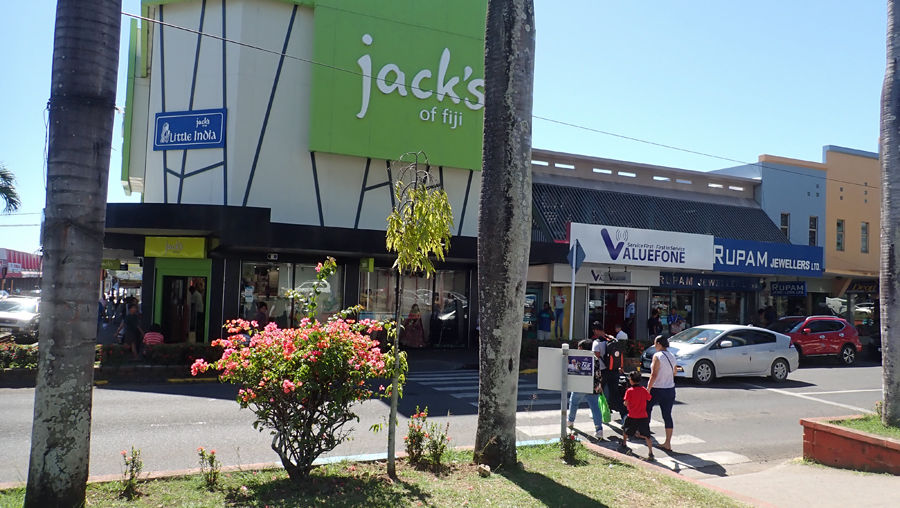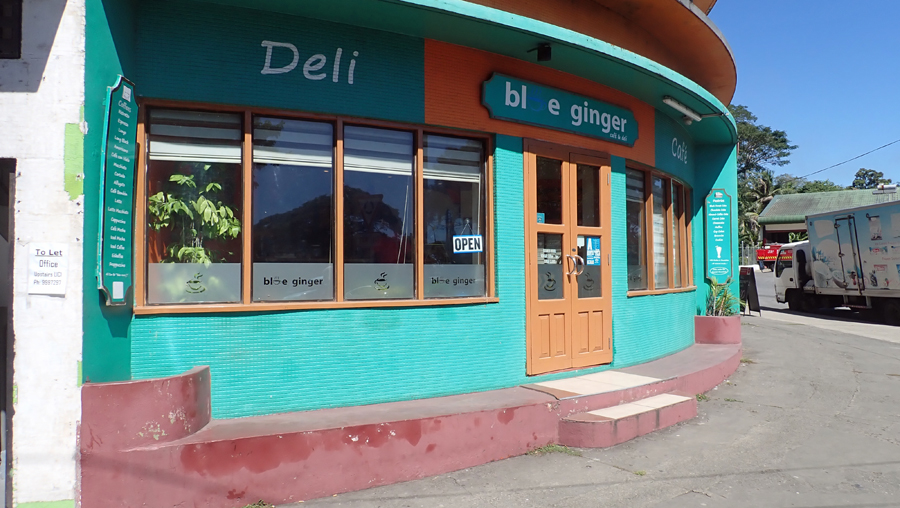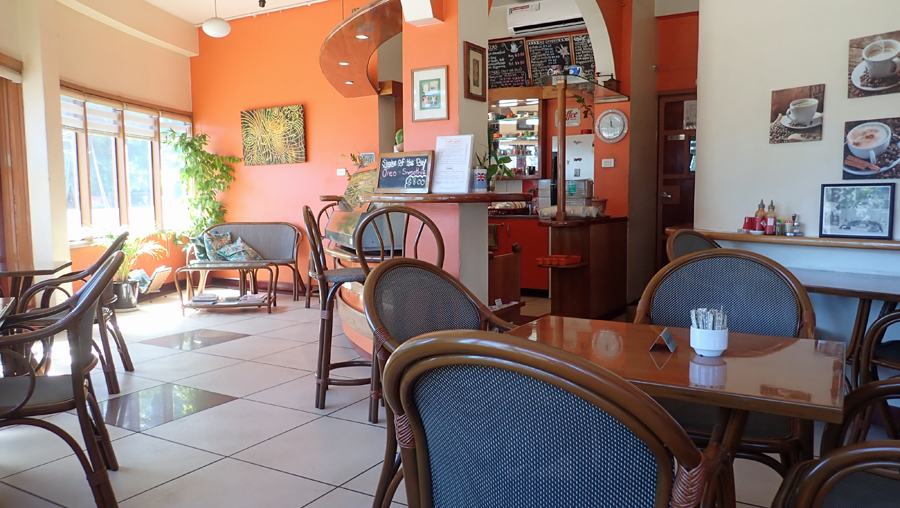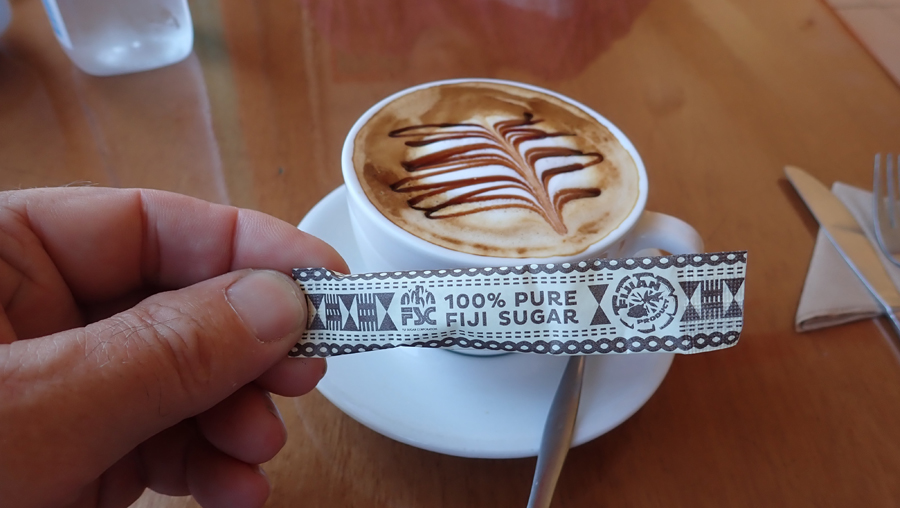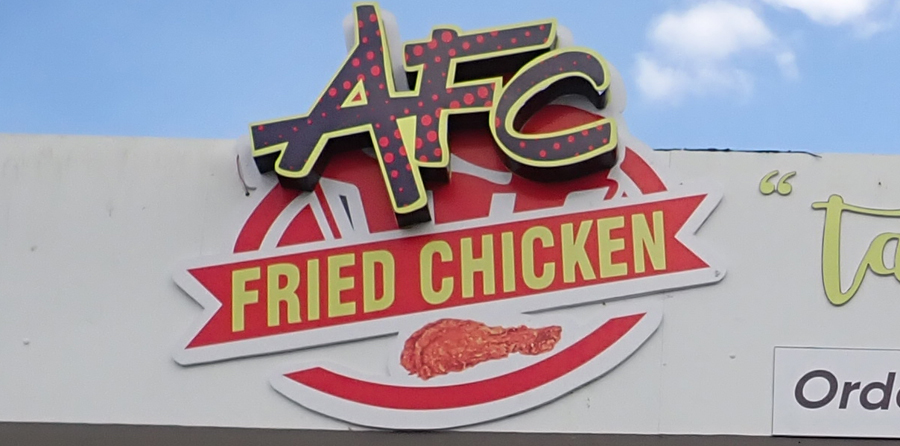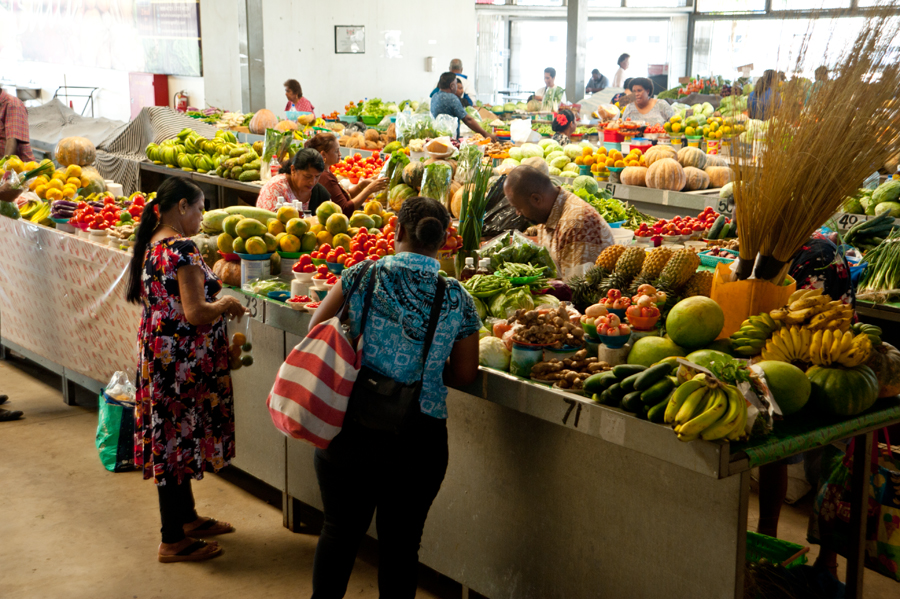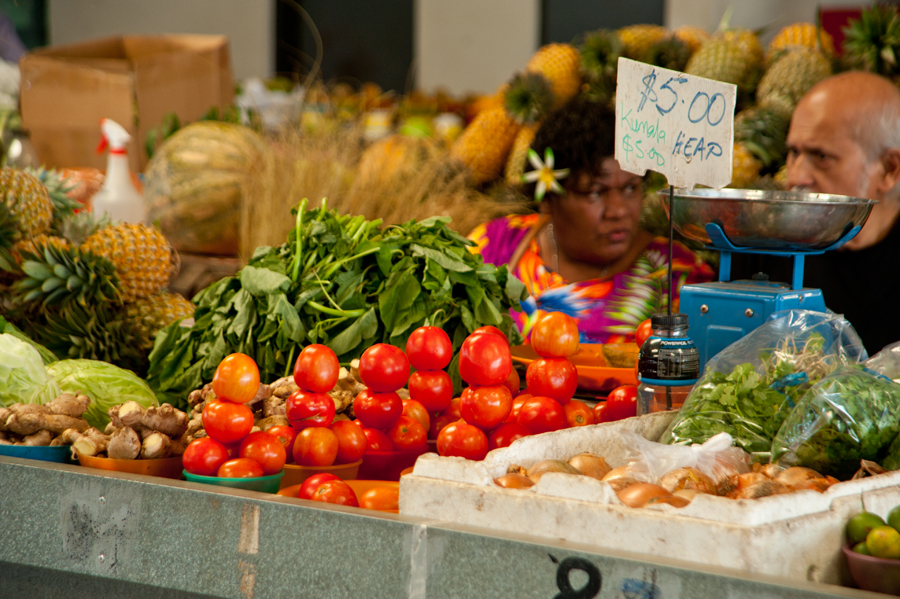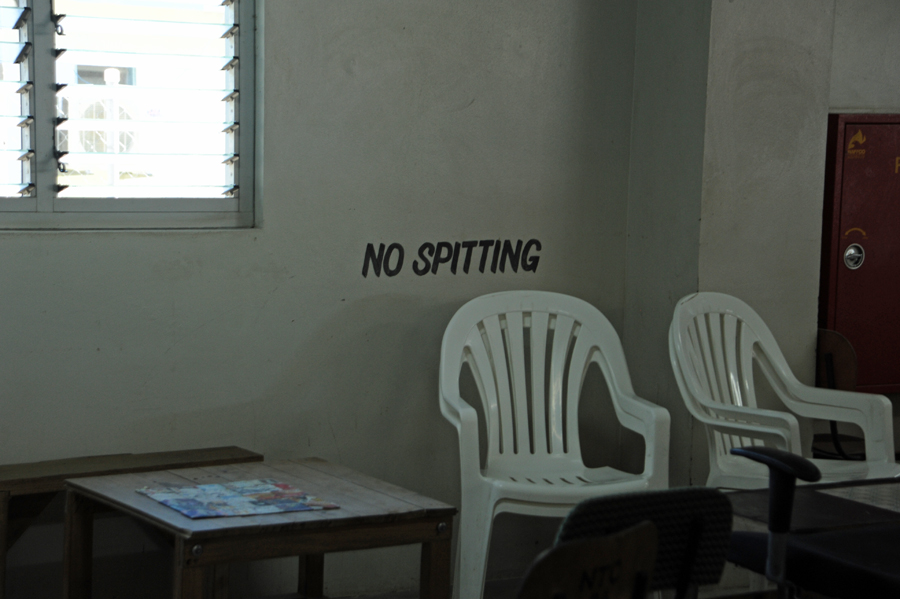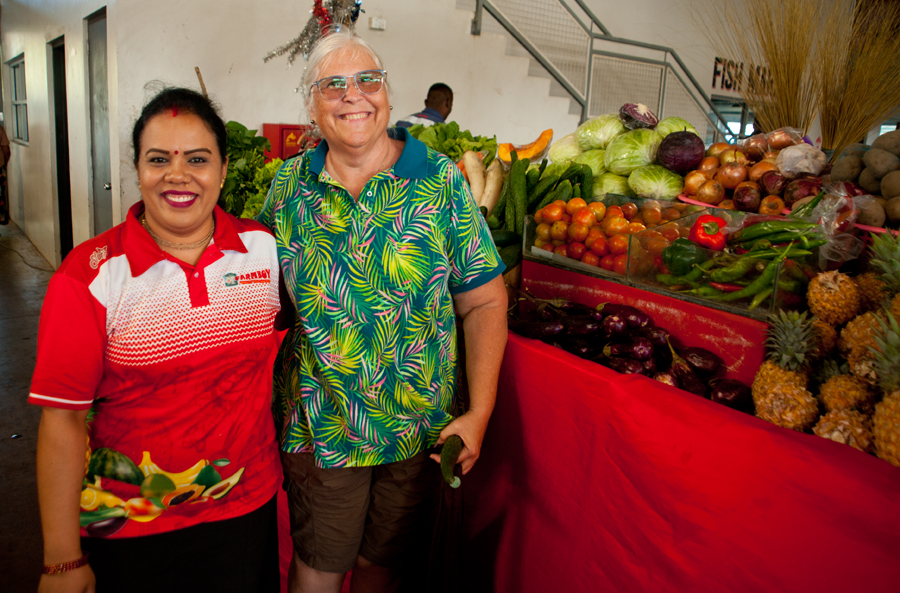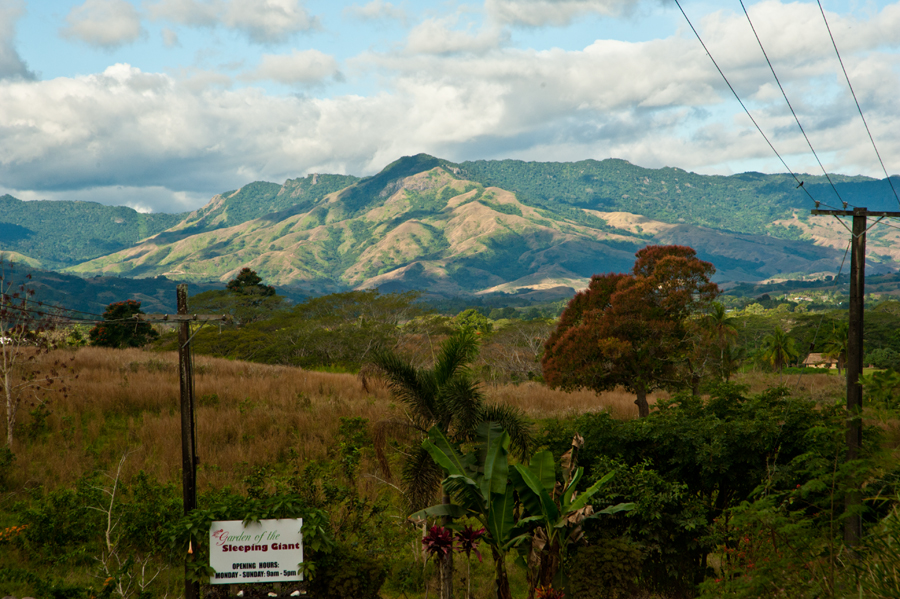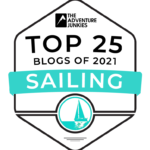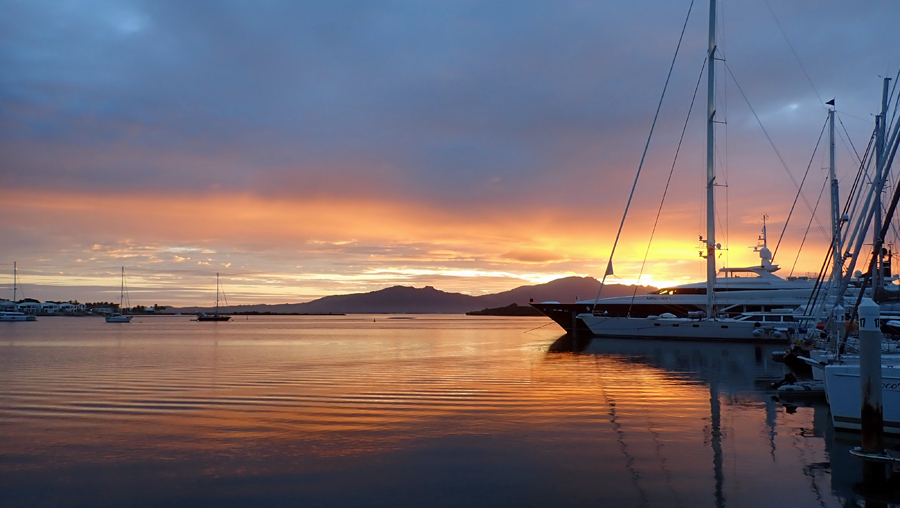
Some mornings we are treated to the most awesome sunrises. Cindy snags this picture while still in PJ’s.
The past few weeks we’ve been doing something we love to do. We’ve been exploring the island we’re on. We are currently on Viti Levu. This is Fiji’s main island and includes the capital city of Suva. I almost called this post Farting Around Fiji but decided to keep it G-rated instead.
About 87% of Fiji’s total 924,610 population live on the two major islands, Viti Levu and Vanua Levu located just north of us. About three-quarters of Fijians live on Viti Levu’s coasts: either in the capital city of Suva; or in smaller urban towns like Nadi or Lautoka. The interior of Viti Levu is sparsely inhabited because of its terrain.
Fiji consists of an archipelago of more than 330 islands of which about 110 are permanently inhabited. There are places you can go here and be the only boat in the cove or the only person on the beach. This reminds me a little bit of the Bahamas where people seeking solitude can still find it. We are not really solitude seekers. Yeah, it’s nice for a few hours and then becomes quite boring for us. I say we, but Cindy quite enjoys a week or two of solitude now and then.
I have to backtrack just a little bit here. When we first arrived in Fiji, we had limited fresh food due to import regulations. After clearing in with the authorities, we needed to do a little grocery shopping to replenish our supplies. Within a short walk of us are two small grocery stores. They vary slightly with the goods they carry so our plans often involve a trip to both stores. On one such day, we found ourselves at Fresh Market, about a 20-minute walk from us. While in line to check out, we chatted with the man behind us.
Once paid up and with our goodies in backpacks, we’re ready for the walk back to the boat. We barely made it out of the store parking lot when the man with whom we had just been talking pulled up in his car and offered us a ride. I already know what you are thinking. Oh hell no! Don’t take candy from strangers and all that. But, things are different here and we graciously accept a ride from a generous stranger.
It turns out he works in the same area as our marina. In his off time from his regular job, he does tours as a private driver. He was quick to give us his card and information. His name is Charlie. During our conversation, we ask what are the top things tourists like to do here. Charlie gives three suggestions: The temple, the Gardens of the Sleeping Giant, and the mud baths. Our ride is short, perhaps less than 5 minutes and we really feel good about the people we are meeting and how friendly and helpful they are.
We have since learned that ride-sharing is a thing here. Hitch-hiking is common. Albeit, not for the tourist but certainly for many locals. People on Viti Levu will ask cars for a ride until a bus comes along. They will stand on the side of a main road and point at the car. This means they are asking for a ride. We’ve seen people of all ages doing this and even a young woman with a baby. We sometimes find ourselves the only people left at a bus stop that was a few minutes ago crowded because people have accepted rides.
This is not the first time we’ve been on an island where asking perfect strangers for a ride is common practice. In Turks and Caicos, jitneys were commonplace. We once asked a lady for directions and she just simply offered to drive us. Rarely there did a person have to wait for long before getting a ride. I wrote a fun blog post about it and how people use the bus stops as pickup points. There are no buses.
Denarau Island, just outside of Nadi is a tourist destination. The island consists of many upscale resort hotels and luxury houses. We have an option of hopping on a tour bus and for a full day pretend we are here on vacation. It didn’t take long to figure out these bus tours are a little bit expensive. An all-day tour, that ironically included all the things Charlie told us to do, was more money on the tour bus than what he had quoted to do it privately. We initially leaned toward calling him. However, we did a little homework before setting out.
Google Maps is our friend. We find the temple is just a short walk from the Nadi bus station. We grab our cameras and head out. We can get to that bus station on the Yellow bus for FJ$1.00 each. And so, our first venture not related to buying boat parts or food is the temple. The Sri Siva Subramaniya Temple is a Hindu temple and is the largest Hindu temple in the Pacific. To enter, there are lots of rules.
There is a strict dress code. We read about this before going. For the first time in years, I find myself wearing long pants with a collared shirt. Boy-oh-boy, it felt really strange to put on long pants. For women, they must wear loose clothing that covers their shoulders and legs. Cindy took her own pareo (sarong) to wrap around her waist. If you do not have one, they have loaners. And, no shoes are allowed anywhere once inside the gate. This meant keeping an eye to the ground the entire time to look for small rocks. There is a very small “donation” required to enter and lots of rules regarding photos.
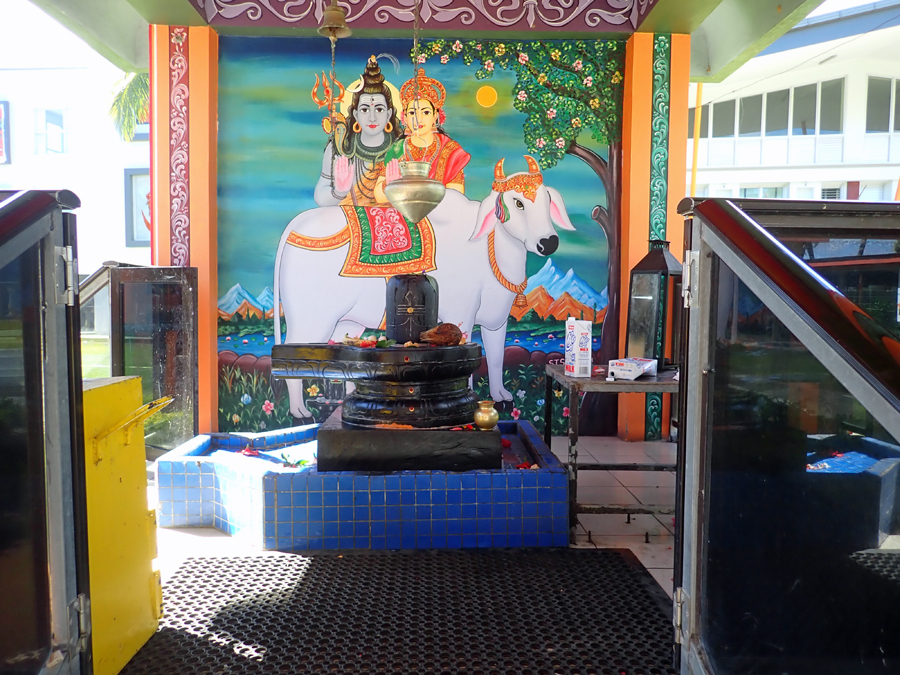
One of the outer buildings looked like an offering place to cows. Based on the empty boxes it seems milk was offered.
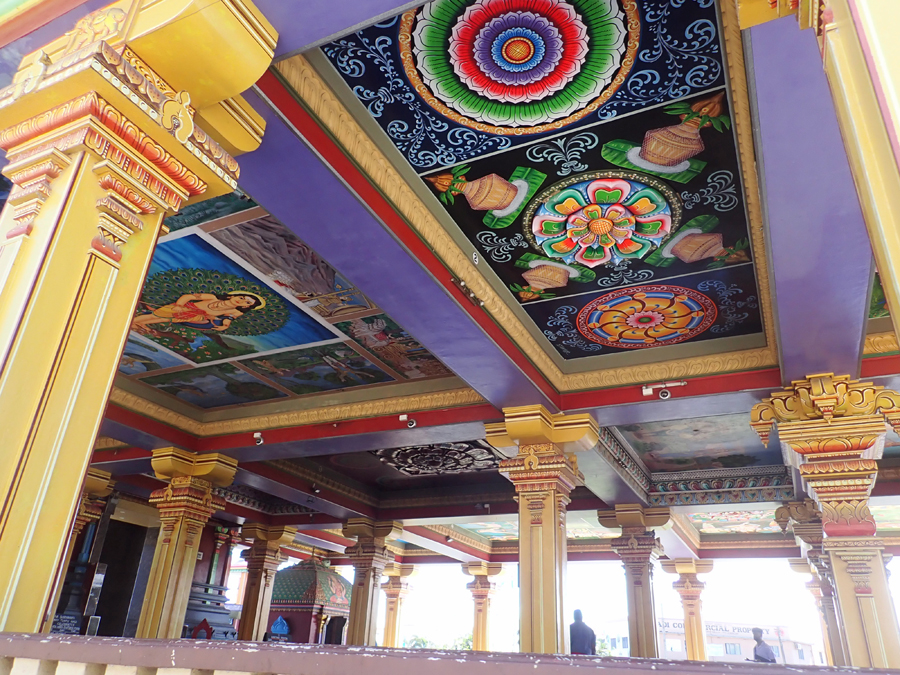
Pictures were not allowed inside the temple but I took this from outside (you can see the rail) looking inside. Perhaps a grey area?
We are really getting used to the bus system here. We’ve even managed to do transfers and multiple destinations. However, the buses limit us to the main streets. And, you know us. We like to travel beyond the main drag and explore. So, this means renting a car. One of our real loves in this lifestyle is to drive aimlessly about and see where the road takes us. It never disappoints.
The car rental costs here are stupid expensive. We shop about and settle for a car from Budget. It isn’t the cheapest but the office is a short walk from the boat and the convenience won over price. Having the car is less than a tour bus and also less than what Charlie quoted us. We did make an effort to use Charlie as a guide but it was just less expensive to blaze our own trail. And besides, with a car, we are not tied to someone else’s itinerary.
After picking up the car, the primary goal was to try to drive on the left side of the road. It’s been a long time since I needed to drive on the left so I put a post-it note at eye-level on the windshield as a reminder. I am proud to say, not once during our time with this car did we try to get in on the wrong side of the car and we also managed to be on the correct side of the street.
In vehicles made for countries where driving on the left is the rule, just about everything in the car is opposite. The turn signal is on the right side of the steering wheel, the wipers are on the left side. This means that just about every turn I signaled I did so with the wipers on. Luckily the peddles are the same.
Cindy made a comment on about day 2 saying she still expected me to move to the right and how things still felt strange. I replied with, I keep pushing the accelerator and expecting something to happen. Our little car is seriously underpowered.
The car was horrible. It was a Suzuki Celerio. My ADD and OCD was irritated and agitated by the fact the steering wheel wasn’t in perfect alignment with the driver’s side seat. It was situated slightly to the right of the seat’s center. This might not have been noticeable to other [normal] people, but for me I immediately found myself sitting more toward the right side of the seat. This caused my neck to hurt. I never really managed to get comfortable in this car.
The seat itself was the most uncomfortable car seat ever. After a couple of days, we both complained of backache. The road noise inside the car was very loud and at times we couldn’t carry on a conversation. I’m not going to go on anymore about my newly acquired hatred for Suzuki Celerios. You tuned in to hear about travel adventures and not car reviews. So, let’s get back on topic. Armed with our cameras we were eager to set out to see what was in store for us. Cindy put together a loose itinerary of stops and routes for our three day adventure.
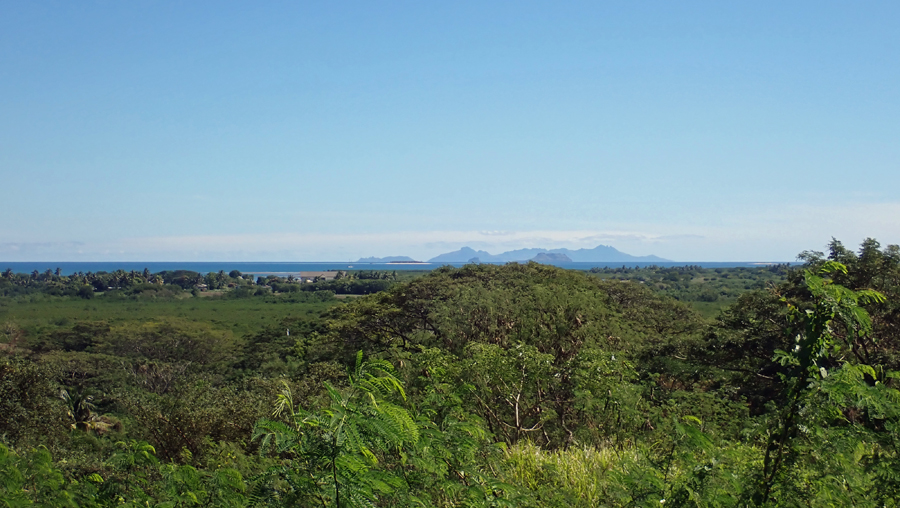
On the road to Vuda Marina, we catch our first glimpse of the Yasawa group of islands we hope to explore soon.
We ventured up to Vuda Marina in the small village of Viseisei. This was an alternative for us when looking for a marina for our time here. It is considerably less expensive than where we are and we soon found out why. It’s in the middle of nowhere. While the marina itself had a nice community and facilities, the docks, or lack of them, made us grateful we opted for Denarau Island.
There are no buses to Vuda Marina and the closest town of Lautoka is about 20-30 minutes away by taxi. If we’d opted to stay there any money saved on marina costs would have been spent on taxis or rental cars. Having easy transportation to town, grocery stores, shops, and tons of fabulous places to eat within a short walk of the Puffster we are spoiled already.
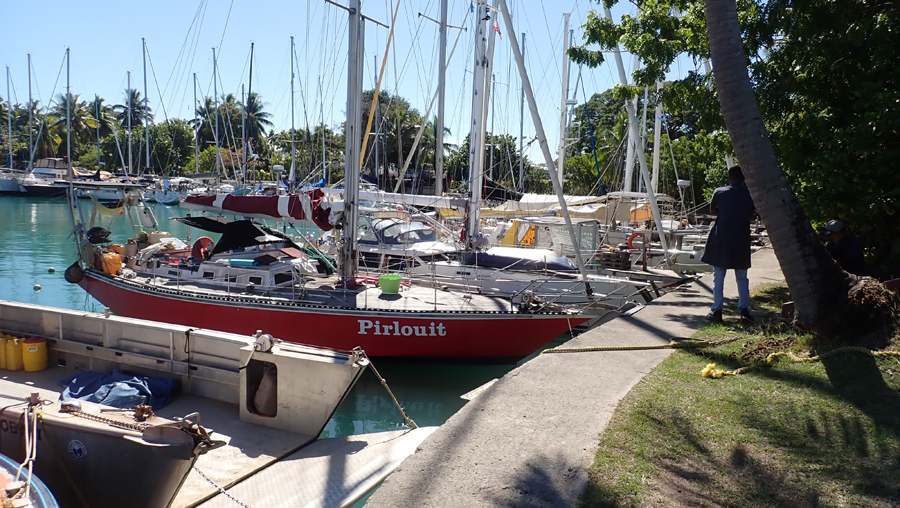
Inside Vuda Marina boats are in a horseshoe-like cove. Being this close to vegetation probably means getting bugs aboard.
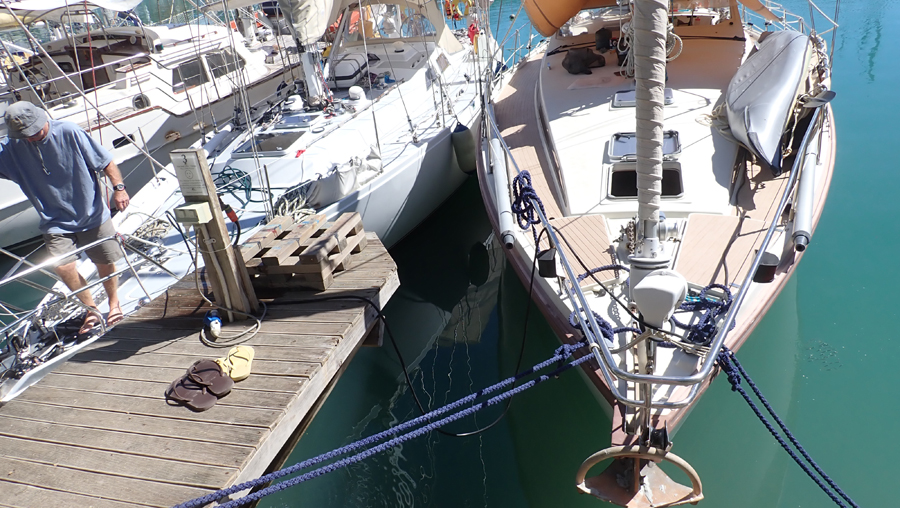
Getting onto the boat is not for geriatric sailors. This is the extent of the dock and a leap of faith must be made to the foredeck – yikes! Not for us!
Driving up to Lautoka, we notice small-scale railroad tracks and wondered what they were for. It’s hard to imagine that an island the size of Fiji would have trains, right? However, we kept seeing signs telling us to watch for trains. When I think of trains, I immediately go to freight or passenger trains. In my wildest dreams, I would have never thought of what we dubbed as a sugarcane train.
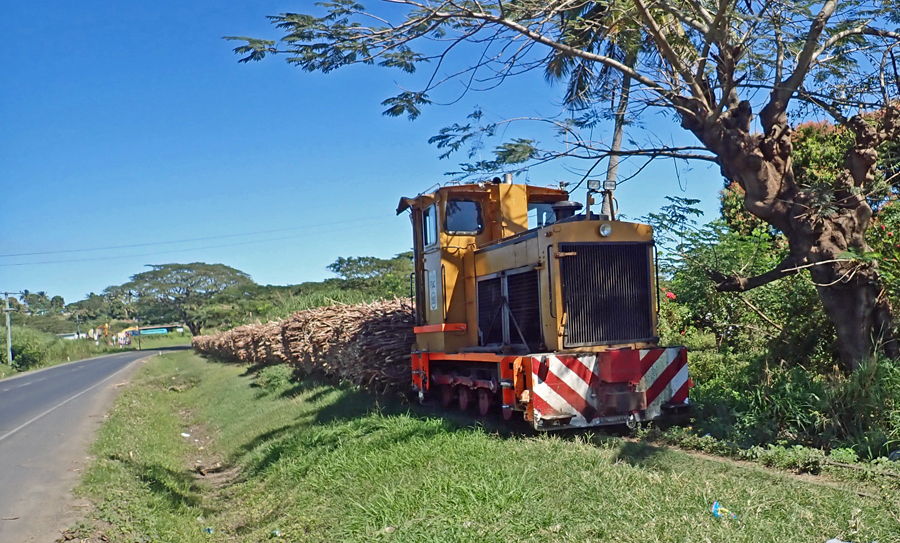
The mystery about the narrow-gauge tracks was solved when we met the sugarcane train – It was VERY long
Lautoka is the heart of the sugarcane industry in Fiji. It is the second largest town on Viti Levu with a population of about 75,000 people and is known to the locals as The Sugar City. It is home to the Colonial Sugar Refining Company which owns the sugar mill founded in 1903.
The main street of the town is divided by tracks for the sugarcane train. We wandered down the middle of these tracks as we looked for a place to eat lunch. Once again using Google Maps, we discovered a nice café. Located on a main traffic circle is the Blue Ginger Café & Deli. How can you not eat at a place with such a creative name? We were a little wary at first since it was past noon and the place was completely empty.
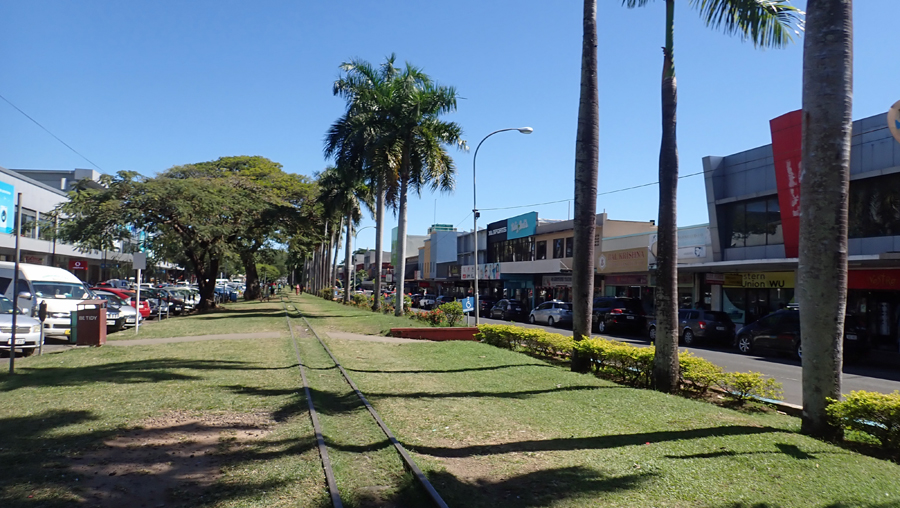
Finding a place to park, we walk down Lautoka’s main street. The sugarcane train tracks make a nice path
The inside of the Blue Ginger Café & Deli is small with less than a dozen tables. It didn’t take long before the place started to fill up. But strangely, it filled with people in tennis outfits. I assumed there might be a tennis center nearby. Google Maps confirms my suspicion.
As our journey continues northward on this side of the island, our conversation turns to how it is arid looking. This reminded me of our first visit to Hawaii where we stayed at what is now the Four Seasons, Kapolei, Oahu. I was expecting lush green vegetation and waterfalls. Instead, it looked like West Texas. We learned way back then how Pacific islands often have a wet side and a dry side. This is true with Fiji.
We pass through the town of Ba. If we blinked, we would’ve missed it. I wonder if there might be a sheep farm. There isn’t. But, how funny would that be to own the Ba Sheep Farm? Even funnier if they were black sheep. [I’ll let that one sink in, Hint, like the song.]
The speed limit island-wide is 80 kph (50 mph) unless otherwise posted. Upon entering small towns or villages like Ba, there are massive speed bumps to slow traffic. I’m talking massive. The kind of speed bump that can launch a small Suzuki Celerio into Earth’s orbit and rip off the undercarriage in the process. Many of these bumps are marked with road signs, but the warning paint on the road is long gone. It really helps having a local driver in front since in many cases we found bumps with no paint or road signs. Cindy would scream “bump” so I could hear her over the noisy car and I’d slam on the brakes.
If we are flashed by another driver traveling in the opposite direction, this means one of two things. The first being the obvious, a cop with a radar gun. We didn’t have to worry about this too much since we don’t speed. For us, traveling at 80 kph seems like light speed. We just need to be careful when the speed limit lowers due to a town. The second is not so obvious. It means there might be a cow or horse on the road. And yes, we’ve seen both.
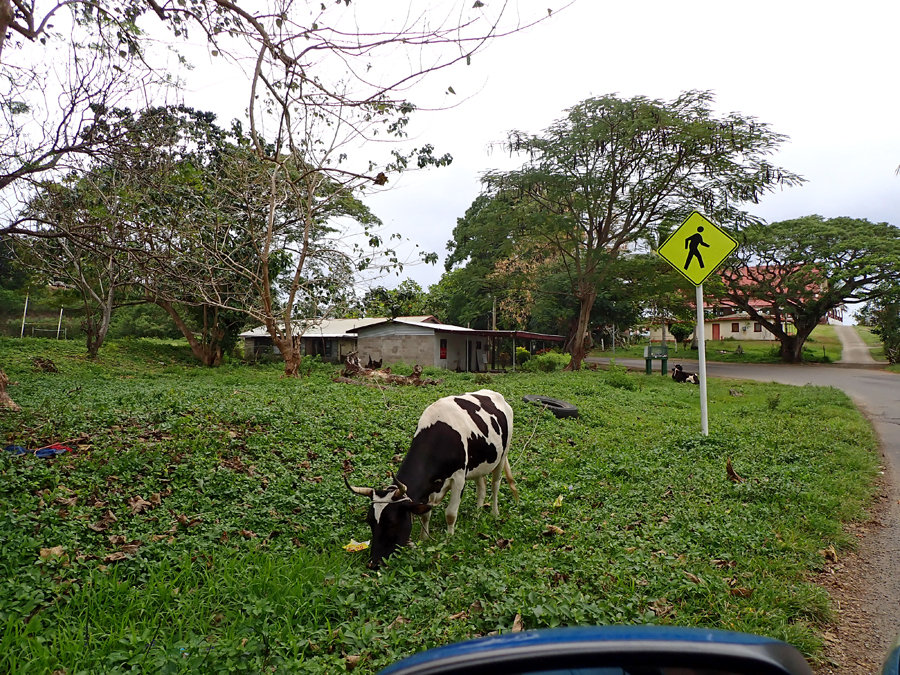
Elsie here is tied to a tire that she can easily drag about. Note how the rope is long enough for her to wander onto the road.
Speaking of guns, the police do not carry guns here. This was proudly pointed out to us by the customs officer who boarded our boat upon arrival. They don’t have guns either. He made mention of the fact how when he visited other countries he found it strange to see officers with weapons, sometimes very large weapons. I can understand why he made this statement with such pride. Being raised in a country where police didn’t carry guns and having spent many years in a place where they do, I much prefer they don’t. It speaks volumes about the nature or climate of the people.
When Cindy and I visited Washington DC (long before the riots), I remember us having a conversation about the police there and the size of their guns. The guns were huge. Outside of the capital building, the police stood with their finger over the trigger area of the weapon. I have to say, that really bothered me.
Since arriving in Fiji, we’ve been using a delivery service for fresh produce. The name of the company is Farm Boy. This sounds somewhat extravagant, but it isn’t. Our alternative option is to bus into Nadi and shop the local market. We can get what we need there but have to schlep a couple of bags back to the marina on the bus. We have two local grocery stores within a short walk but their produce is lacking. It is much easier to have it delivered, and the delivery for us is free.
There are a few mega-yachts down the dock from us who use this service. Farm Boys is delivering here at least once per day and when supplying the large private boats has a big load of goodies they wheel down the dock on a trolly. If we order in the morning, our order arrives the same day since they need to come here anyway. Cindy will send an email of what we’d like to have and magically there is a knock on the boat a few hours later. On the last delivery, we met the owner, Kamlesh Prasad, and his daughter. They happily spent some time telling us their story.
The company started as a small roadside stand in 2000 and then moved into the Namaka Market. They coined the company name Farm Boy in 2009. The stand is still in the market but the delivery service has exploded over the years. They deliver to all the islands so long as there’s a ferry service to the end location. This means yachties can get fresh produce. Farm Boy has a big presence on FaceBook and is mentioned in most cruising guides. Since the business has grown, they now have more farmers as partners adding to the assortment and freshness. They have expanded into meat due to a new partnership with South Pacific Butcher Shop in Nadi. I also found they deliver beer. And, the price of the beer is better than the grocery store or wine shop. How awesome is that?
Kamlesh told us if we are in the area take time to visit the Namaka Market. However, he made firm stipulations. If we did visit, we’re only allowed to take pictures. If we buy anything, it must be from his stand. When driving along we saw the market and decided to stop and say hello. Plus, we needed a couple of things. And, we did as we were told. We took pictures and picked up some fresh veggies from his stand.
Next up: The Gardens of the Sleeping Giant, a yard monument that tops Elton John’s tram, farm-to-table concepts, and more as we continue our exploration.
